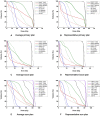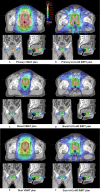Treatment plan comparison between Tri-Co-60 magnetic-resonance image-guided radiation therapy and volumetric modulated arc therapy for prostate cancer
- PMID: 29207634
- PMCID: PMC5710914
- DOI: 10.18632/oncotarget.20039
Treatment plan comparison between Tri-Co-60 magnetic-resonance image-guided radiation therapy and volumetric modulated arc therapy for prostate cancer
Abstract
To investigate the plan quality of tri-Co-60 intensity-modulated radiation therapy (IMRT) with magnetic-resonance image-guided radiation therapy compared with volumetric-modulated arc therapy (VMAT) for prostate cancer. Twenty patients with intermediate-risk prostate cancer, who received radical VMAT were selected. Additional tri-Co-60 IMRT plans were generated for each patient. Both primary and boost plans were generated with tri-Co-60 IMRT and VMAT techniques. The prescription doses of the primary and boost plans were 50.4 Gy and 30.6 Gy, respectively. The primary and boost planning target volumes (PTVs) of the tri-Co-60 IMRT were generated with 3 mm margins from the primary clinical target volume (CTV, prostate + seminal vesicle) and a boost CTV (prostate), respectively. VMAT had a primary planning target volume (primary CTV + 1 cm or 2 cm margins) and a boost PTV (boost CTV + 0.7 cm margins), respectively. For both tri-Co-60 IMRT and VMAT, all the primary and boost plans were generated that 95% of the target volumes would be covered by the 100% of the prescription doses. Sum plans were generated by summation of primary and boost plans. In sum plans, the average values of V70 Gy of the bladder of tri-Co-60 IMRT vs. VMAT were 4.0% ± 3.1% vs. 10.9% ± 6.7%, (p < 0.001). Average values of V70 Gy of the rectum of tri-Co-60 IMRT vs. VMAT were 5.2% ± 1.8% vs. 19.1% ± 4.0% (p < 0.001). The doses of tri-Co-60 IMRT delivered to the bladder and rectum were smaller than those of VMAT while maintaining identical target coverage in both plans.
Keywords: magnetic-resonance image-guided radiation therapy; prostate cancer; volumetric modulated arc therapy.
Conflict of interest statement
CONFLICTS OF INTEREST The authors indicated no conflicts of interest.
Figures


Similar articles
-
A comparison of treatment plan quality between Tri-Co-60 intensity modulated radiation therapy and volumetric modulated arc therapy for cervical cancer.Phys Med. 2017 Aug;40:11-16. doi: 10.1016/j.ejmp.2017.06.018. Epub 2017 Jul 29. Phys Med. 2017. PMID: 28760506
-
A comparative planning study for lung SABR between tri-Co-60 magnetic resonance image guided radiation therapy system and volumetric modulated arc therapy.Radiother Oncol. 2016 Aug;120(2):279-85. doi: 10.1016/j.radonc.2016.06.013. Epub 2016 Jul 8. Radiother Oncol. 2016. PMID: 27401404
-
Prostate and seminal vesicle volume based consideration of prostate cancer patients for treatment with 3D-conformal or intensity-modulated radiation therapy.Med Phys. 2010 Jul;37(7):3791-801. doi: 10.1118/1.3451125. Med Phys. 2010. PMID: 20831087
-
SU-E-T-599: Pelvic Volumetric Modulated Arc Therapy with Hypofractionated Concomitant Integrated Prostate Boost: An Isoeffective Dose Comparison.Med Phys. 2012 Jun;39(6Part19):3843. doi: 10.1118/1.4735688. Med Phys. 2012. PMID: 28517088
-
Quality of tri-Co-60 MR-IGRT treatment plans in comparison with VMAT treatment plans for spine SABR.Br J Radiol. 2017 Feb;90(1070):20160652. doi: 10.1259/bjr.20160652. Epub 2016 Dec 8. Br J Radiol. 2017. PMID: 27781486 Free PMC article.
Cited by
-
Analysis of a volumetric-modulated arc therapy (VMAT) single phase prostate template as a class solution.Rep Pract Oncol Radiother. 2019 Jan-Feb;24(1):92-96. doi: 10.1016/j.rpor.2018.10.009. Epub 2018 Nov 22. Rep Pract Oncol Radiother. 2019. PMID: 30505239 Free PMC article.
-
From CBCT to MR-Linac in Image-Guided Prostate Cancer Radiotherapy Towards Treatment Personalization.Curr Oncol. 2025 May 22;32(6):291. doi: 10.3390/curroncol32060291. Curr Oncol. 2025. PMID: 40558234 Free PMC article. Review.
-
Comparison of treatment plan quality among MRI-based IMRT with a linac, MRI-based IMRT with tri-Co-60 sources, and VMAT for spine SABR.PLoS One. 2019 Jul 22;14(7):e0220039. doi: 10.1371/journal.pone.0220039. eCollection 2019. PLoS One. 2019. PMID: 31329641 Free PMC article.
-
The impact of margin reduction on radiation dose distribution of ultra-hypofractionated prostate radiotherapy utilizing a 1.5-T MR-Linac.J Appl Clin Med Phys. 2024 Jan;25(1):e14179. doi: 10.1002/acm2.14179. Epub 2023 Nov 27. J Appl Clin Med Phys. 2024. PMID: 38013636 Free PMC article.
-
Results of a multicenter intensity modulated radiation therapy treatment planning comparison study for a sample prostate cancer case.Strahlenther Onkol. 2019 Oct;195(10):913-922. doi: 10.1007/s00066-019-01496-9. Epub 2019 Jul 24. Strahlenther Onkol. 2019. PMID: 31342106 English.
References
-
- Aizer AA, Yu JB, Colberg JW, McKeon AM, Decker RH, Peschel RE. Radical prostatectomy vs. intensity-modulated radiation therapy in the management of localized prostate adenocarcinoma. Radiother Oncol. 2009;93:185–191. - PubMed
-
- Zelefsky MJ, Fuks Z, Happersett L, Lee HJ, Ling CC, Burman CM, Hunt M, Wolfe T, Venkatraman ES, Jackson A, Skwarchuk M, Leibel SA. Clinical experience with intensity modulated radiation therapy (IMRT) in prostate cancer. Radiother Oncol. 2000;55:241–249. - PubMed
-
- Mah D, Freedman G, Milestone B, Hanlon A, Palacio E, Richardson T, Movsas B, Mitra R, Horwitz E, Hanks GE. Measurement of intrafractional prostate motion using magnetic resonance imaging. Int J Radiat Oncol Biol Phys. 2002;54:568–575. - PubMed
LinkOut - more resources
Full Text Sources
Other Literature Sources

